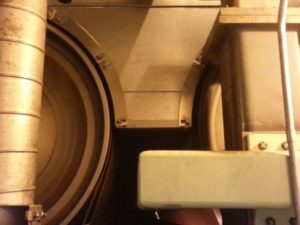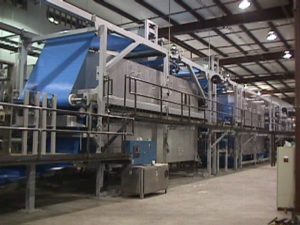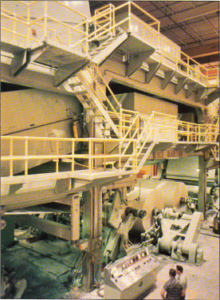Dryers and Ovens
AIRTHERM dryers match heat transfer technology with your product!
AIRTHERM offers a variety of dryers and ovens including impingement dryers, high temperature impingement nozzles, flotation dryers or thru-air dryer type designs to meet any application; continuous dryers for web and bulk materials, batch processing ovens and arch dryers with roll or conveyorized support of the sheet or material. Supply air units can use steam, gas and electric heating with direct or indirect heat transfer. Fresh air and re-circulation type systems are designed for up to 1500 °F air temperature and 30,000 FPM air velocity. CFD analysis of the dryer system is used to ensure uniform airflow and temperature to the product. Simple, single-loop temperature control panels or automatic PLC-based control systems are available to meet your needs.
Impingement Dryer – MB and 2MB slotted box designs are used for medium air velocity and temperature drying. Low profile, return tube designs are used for applications with restricted head space. High efficiency round impingement nozzles are typically used for high temperature and velocity to provide the highest drying rates and efficiencies. Nozzles are sized and spaced for optimum heat transfer. Cross-machine profile dampers provide control over dry edges, curl, stretch and the moisture profile.
HT “High Temperature” Impingement Nozzles – a hybrid between a vapor absorption nozzle and an impingement dryer, HT nozzles can be used to deliver heated air to the dryer section. Individual high temperature nozzles (300 – 600 °F) are designed to blow directly on the sheet in a machine dryer section (without felts) to increase the drying rate. The nozzles can be used in dryer sections upstream of breaker stacks, coaters, saturators or corrugators to control the entering sheet moisture and affect the speed of the overall machine. HT nozzles can also be installed on the entire dryer section to boost drying and increase production. Systems can be single or multi-zoned for gradual, controlled drying. Sheet curl can be affected by controlling upper and lower HT Nozzles using different air velocities and temperatures. Moisture profiling can also be accomplished with segmented HT nozzles that allow for internal dampening. The HT nozzle system can increase production by 5-25%. The system performance increases with increased temperature, higher nozzle velocity and closeness to the sheet. Captured paper machine hood exhaust will be recirculated from the machine hood to conserve energy. The air will be mixed with preheated fresh air, circulated through a burner and delivered back to the nozzles similar to a conventional dryer system. Retraction mechanisms are available if required for threading and dryer access.
Flotation Dryer – The most effective way to dry the majority of non-porous and low porosity webs, Flotation Dryers can be designed for single or double sided drying applications and produce a higher overall drying rate. AF and TF slotted nozzle box designs use the Coanda effect to maximize aerodynamically induced heat transfer to the web, avoid dead spots and maintain a substantially uniform drying rate across the machine. The nozzle boxes are spaced to meet specific web carrying and drying needs. The airflow direction can be arranged co-current for slow web speeds or counter-flow to that of the web at higher web speeds. The dryers are configured as single or multi-zone units. 2-sided, TF nozzle box designed dryers allow for lower sheet tension, better edge curl control and the highest heat transfer.
Flat-Bed Thru-Air Dryer – Designed for high permeability web drying, the AIRTHERM Thru-Dryer offers the highest efficiency air drying method as opposed to standard convective or conductive drying options. More economical than using multiple open roll rotary dryers, and the flat-bed design will not impart internal stresses associated with drying the sheet on a curvature.
Heated air passes through the web carried on a conveying wire in a straight horizontal or vertical plane. Air contacts every fiber removing moisture both mechanically and thermodynamically. Uniform air distribution, temperature and suction through the sheet is guaranteed using CFD analysis.
There are various types of conveying wires available – stainless steel and synthetic. A return wire enclosure with hot air ventilation is used to keep wire warm and enclosure under a negative pressure.
Various control and monitoring options are available to meet the customer’s requirement.


